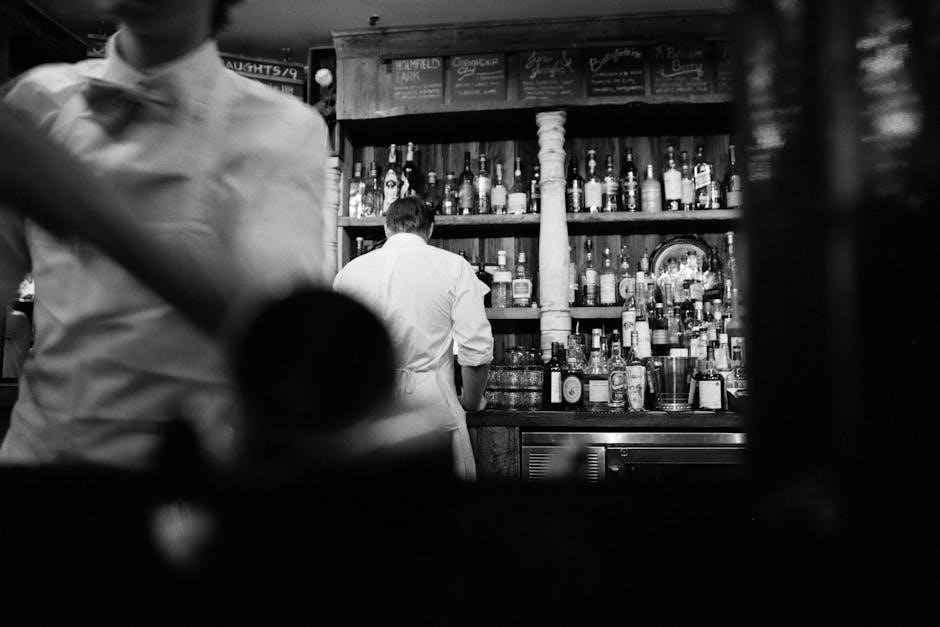Bartending is a blend of creativity‚ knowledge‚ and interpersonal skills‚ transforming simple ingredients into memorable experiences. It requires mastering essential tools‚ understanding flavor profiles‚ and creating a welcoming environment for patrons.
Understanding the Role of a Bartender
Bartending is more than just mixing drinks; it’s about creating experiences‚ ensuring safety‚ and connecting with people. A bartender must recognize signs of intoxication‚ handle difficult customers gracefully‚ and maintain a clean workspace. They should be knowledgeable about drink recipes‚ ingredients‚ and tools. Beginner bartenders should get plenty of rest‚ wear comfortable shoes‚ and be honest when unsure about a drink. Building trust with coworkers and patrons is key‚ as teamwork and communication are vital. A bartender’s role is multifaceted‚ requiring attention to detail‚ patience‚ and a passion for hospitality to ensure every patron leaves satisfied and safe.
Essential Tools Every Bartender Needs
A well-equipped bartender relies on a few key tools to craft exceptional drinks. A glass scoop is indispensable for portioning ingredients accurately‚ while hand-packed ice ensures proper dilution and texture. Jiggers or measuring cups are crucial for precise pours‚ and shakers are essential for mixing. Muddlers are necessary for crushing fruits and herbs‚ and a Hawthorne or julep strainer helps filter ice and solids. Garnish tools like knives or peelers add the finishing touches. These tools‚ when used correctly‚ elevate the bartending process and contribute to creating memorable cocktails.

Mastering Drink Recipes
Mastering drink recipes involves perfecting classic cocktails and experimenting with modern twists. Techniques like double-shaking and balancing flavors ensure exceptional results‚ making every sip memorable and refined.
Classic Cocktails Every Bartender Should Know
Mastering classic cocktails is fundamental for any bartender. The Old Fashioned‚ Margarita‚ Daiquiri‚ and Whiskey Sour are timeless favorites that showcase fundamental techniques. A perfect Martini‚ with equal parts sweet and dry vermouth‚ is a staple. The Manhattan‚ blending whiskey and vermouth‚ and the Cosmopolitan‚ with its fruity twist‚ are also essentials. These drinks rely on precise measurements and balance of flavors. Understanding their origins and variations allows bartenders to craft authentic versions while adapting to modern tastes. Double-shaking and flavor balancing are key techniques to perfect these iconic recipes‚ ensuring a refined and memorable experience for patrons.
Modern Twists on Traditional Drinks
Modern mixology encourages creativity by reinventing classic recipes with unique flavor profiles and techniques. Bartenders experiment with infusions‚ ferments‚ and house-made ingredients to offer fresh takes on beloved drinks. For instance‚ smoked spirits or rare bitters can elevate a traditional cocktail. Sustainability is also a focus‚ with bartenders incorporating locally sourced or organic components. Presentation plays a role too‚ as creative glassware and artistic garnishes enhance the visual appeal. These innovative approaches allow bartenders to pay homage to classic recipes while introducing something new and exciting‚ keeping the craft dynamic and engaging for adventurous patrons seeking distinctive experiences.
Specialty Drinks for Specific Occasions
Specialty drinks are crafted to complement specific events‚ such as weddings‚ holidays‚ or themed parties. For instance‚ a champagne cocktail like the French 75 shines at celebratory gatherings‚ while a warm spiced cider is perfect for autumnal events. Signature drinks tailored to an occasion’s theme enhance the experience‚ creating memorable moments for patrons. Bartenders often experiment with seasonal ingredients or unique flavor combinations to craft these exclusive offerings. Whether it’s a refreshing summer spritz or a rich‚ spiced eggnog for winter‚ these drinks are designed to elevate the atmosphere and leave a lasting impression on guests.
Developing Interpersonal Skills
Effective communication and empathy are key to building rapport with patrons. Bartenders must master active listening‚ maintain positivity‚ and navigate diverse personalities to ensure a welcoming atmosphere.
Mastering Small Talk and Icebreakers
Small talk is a bartender’s superpower‚ fostering connections and creating a welcoming atmosphere. Start with simple questions like‚ “What are your plans for the night?” or “Are you from around here?” These icebreakers help patrons feel at ease. Active listening is key—show genuine interest and adapt your approach to different personalities. Keep conversations light and positive‚ avoiding controversial topics. Humor and enthusiasm can turn a routine interaction into a memorable experience. Remember‚ the goal is to make every patron feel valued‚ ensuring they leave with a smile and a reason to return;
Handling Difficult Customers with Grace
Dealing with challenging patrons requires patience and professionalism. Maintain a calm demeanor‚ actively listen to their concerns‚ and acknowledge their feelings. Avoid taking criticism personally and focus on finding solutions. Use phrases like‚ “I understand‚ let me help‚” to show empathy. If a customer is intoxicated‚ handle the situation discreetly by offering water or politely declining further service. Stay firm yet respectful when enforcing bar policies. Remember‚ turning a negative experience into a positive one can enhance your reputation and encourage repeat business. Grace under pressure is key to maintaining a positive bar environment.

Managing the Bar Environment
Organizing tools efficiently‚ maintaining cleanliness‚ and ensuring safety are crucial. A well-structured workspace enhances productivity and provides a pleasant experience for both staff and patrons.
Setting Up Your Bar for Efficiency
Efficiency behind the bar starts with a well-organized setup. Arrange your tools and ingredients strategically to minimize movement. Keep essential tools like jiggers‚ shakers‚ and muddlers within easy reach. Glassware should be organized by type‚ with highballs and margarita glasses separated for quick access. Preparing garnishes and setting up ice baths in advance saves time during peak hours. Position your most-used spirits and mixers at eye level to streamline drink preparation. Finally‚ ensure your workspace is clean and clutter-free‚ allowing you to focus on crafting drinks seamlessly. A well-organized bar enhances both speed and customer satisfaction.
Maintaining a Clean and Safe Workspace
Maintaining a clean and safe workspace is crucial for both hygiene and efficiency. Regularly sanitize all surfaces‚ including countertops‚ taps‚ and equipment‚ using food-safe cleaners. Ensure all tools‚ such as jiggers and shakers‚ are washed and dried thoroughly after use. Properly dispose of waste‚ including fruit peels and broken glass‚ to prevent hazards. Store ingredients and spirits in their designated areas to avoid contamination. Keep the floor clear of spills to prevent slips‚ and always check expiration dates of mixers and syrups. A clean workspace not only ensures safety but also enhances productivity and professionalism behind the bar.

Advanced Bartending Techniques
Mastering advanced techniques like dry shaking‚ double-shaking‚ and precise flavor balancing elevates cocktail creation. These methods refine texture‚ clarity‚ and taste‚ ensuring exceptional drink quality and presentation.
Perfecting the Art of Mixing and Shaking
Mastering mixing and shaking techniques is crucial for creating balanced‚ smooth cocktails. Dry shaking (without ice) ensures emulsification of ingredients like eggs or cream‚ while double-shaking (with and without ice) enhances clarity and texture. Timing and vigor are key—over-shaking dilutes flavors‚ while under-shaking leaves ingredients unblended. Practice gripping the shaker firmly and using a swift‚ rhythmic motion. For unknown drinks‚ honesty is best—ask the customer for details to craft their desired flavor profile. These skills refine your craft‚ delivering exceptional results and impressing even the most discerning patrons.
Understanding Flavor Profiles and Pairings
Understanding flavor profiles is key to crafting exceptional cocktails. Recognizing how sweet‚ sour‚ bitter‚ and umami elements interact allows bartenders to balance drinks harmoniously. Pairing complementary flavors‚ like citrus with gin or smoky mezcal with spicy notes‚ elevates creations. Familiarity with spirits‚ syrups‚ and mixers is essential. For instance‚ a perfect martini balances sweet and dry vermouth. When unsure of a drink‚ ask the customer for details to tailor the flavor profile. This skill not only enhances creativity but also ensures every sip is a delightful experience‚ making even unfamiliar recipes memorable and satisfying for patrons.

Health and Safety in Bartending
Recognizing signs of intoxication is crucial for responsible serving. Maintain a clean workspace to prevent accidents and ensure patron safety‚ adhering to hygiene standards and safety protocols.
Recognizing Signs of Intoxication
Recognizing signs of intoxication is vital for responsible bartending. Common indicators include slurred speech‚ unsteady posture‚ glassy or bloodshot eyes‚ and overly loud or inappropriate behavior. Patrons may also exhibit poor judgment‚ such as ordering multiple drinks quickly or appearing disoriented. Bartenders should monitor these signs and refuse service to those showing clear intoxication. Additionally‚ offering water and encouraging patrons to pace themselves can help prevent over-intoxication. Proper training and awareness are essential to ensure a safe and enjoyable environment for all customers while adhering to legal and ethical standards.
Preventing Workplace Injuries
Preventing workplace injuries is crucial for a safe and efficient bar environment. Bartenders should ensure proper lifting techniques‚ avoid overreaching‚ and maintain a clean workspace to reduce slip hazards. Regularly cleaning up spills and organizing tools can prevent accidents. Wearing non-slip shoes and using ergonomic equipment‚ like a sturdy muddler or jigger‚ can reduce strain. Encouraging teamwork‚ such as helping coworkers with heavy tasks‚ also promotes safety. Establishing a routine for handling glassware and sharp objects carefully minimizes risks. A proactive approach to safety ensures a secure workspace for both staff and patrons‚ fostering a positive and injury-free atmosphere.
Continuous Learning and Growth in Bartending
Continuous learning is key to excelling in bartending. Staying updated on trends‚ techniques‚ and ingredients ensures growth. Experiment with new recipes‚ attend workshops‚ and seek feedback to refine skills. Learning from experienced bartenders and exploring diverse cocktail cultures can inspire creativity. Embrace challenges‚ such as crafting original drinks or mastering advanced methods like molecular mixology. Sharing knowledge with peers fosters a supportive community. Remember‚ bartending is both an art and a science‚ requiring adaptability and passion. By committing to lifelong learning‚ bartenders can evolve their craft‚ innovate‚ and deliver exceptional experiences for patrons.